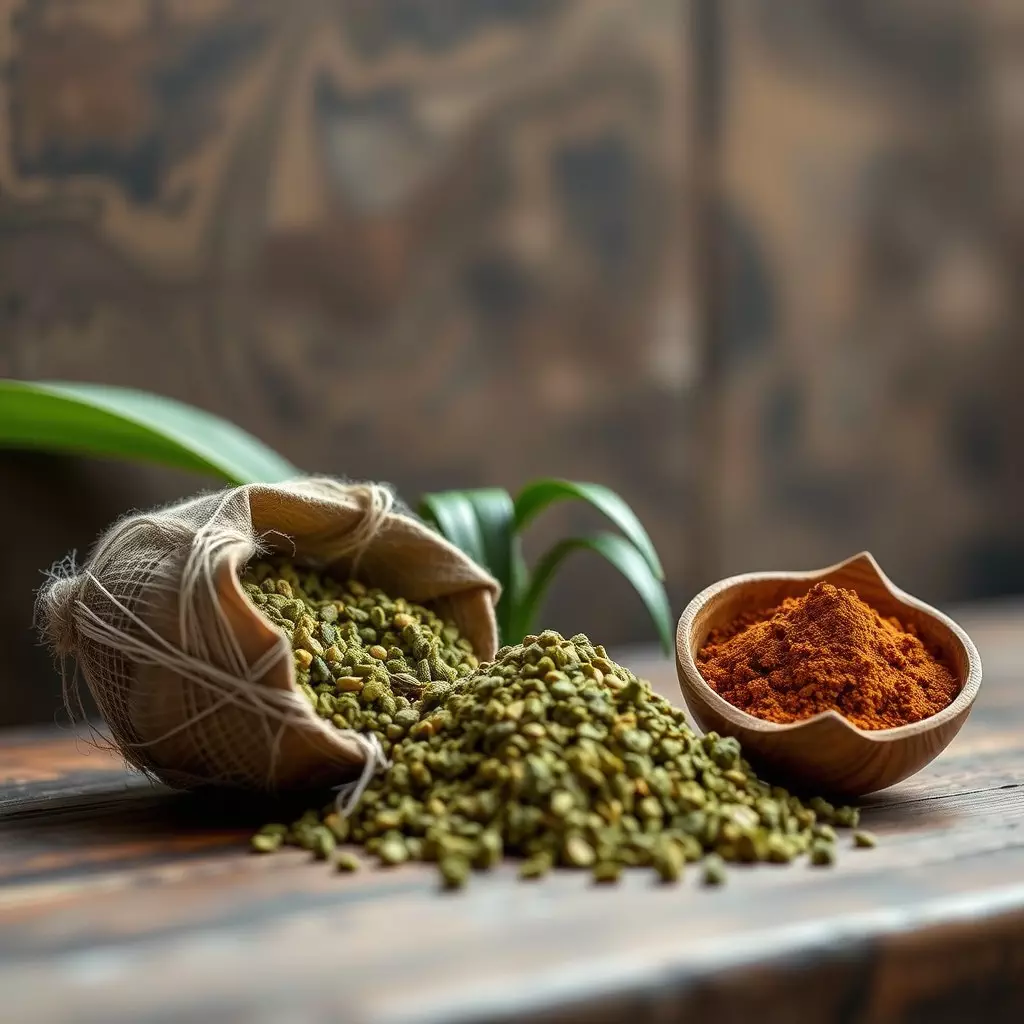Green Maeng Da and Red Bali are two kratom strains that show promise in aiding opioid withdrawal symptoms, with each offering distinct benefits. Green Maeng Da is known for its energizing and mood-enhancing effects, which can help individuals experiencing physical discomforts like muscle aches, anxiety, and irritability during detoxification. Its alkaloid composition, particularly mitragynine and 7-hydroxymitragynine, supports focus and productivity without sedation. In contrast, Red Bali is celebrated for its calming and soothing properties, which can be beneficial for managing the emotional and psychological challenges of opioid cessation, such as mood swings, restlessness, and sleep disturbances. Its higher levels of 7-hydroxymitragynine provide potent pain relief and relaxation, making it ideal for post-detoxification support and promoting a restful state and anxiety management. User experiences indicate that both strains can be effective within a holistic treatment strategy for opioid withdrawal, though it's crucial to use kratom under medical guidance due to potential interactions with other substances. The comparative effects of Green Maeng Da versus Red Bali highlight the importance of further scientific research to validate their use in managing withdrawal symptoms and ensure safe usage.
exploring the potential benefits of kratom varieties such as Green Maeng Da and Red Bali in managing opioid withdrawal symptoms, this article delves into the empirical evidence supporting their efficacy. We will compare these strains, noting their distinct alkaloid profiles and how they may influence the detoxification process. User experiences provide valuable insights into the practical implications of choosing between Green Maeng Da and Red Bali during opioid withdrawal, offering a comprehensive overview of their roles in mitigating discomfort associated with this challenging transition.
- Exploring the Efficacy of Green Maeng Da and Red Bali Kratom in Mitigating Opioid Withdrawal Symptoms
- Understanding the Differences Between Green Maeng Da and Red Bali: A Comprehensive Comparison for Opioid Detoxification
- User Experiences and Analyzing the Impact of Green Maeng Da vs Red Bali for Alleviating Withdrawal Discomfort
Exploring the Efficacy of Green Maeng Da and Red Bali Kratom in Mitigating Opioid Withdrawal Symptoms

Kratom, a plant from Southeast Asia with leaves that contain compounds that can have psychoactive effects, has garnered attention for its potential role in alleviating opioid withdrawal symptoms. Among the strains of kratom, Green Maeng Da and Red Bali stand out due to their distinct alkaloid profiles and reported efficacy in managing withdrawal discomforts. The Green Maeng Da strain is renowned for its invigorating and pain-relieving properties, which may help mitigate the physical symptoms of withdrawal, such as muscle aches, anxiety, and irritability. Users often report that this strain provides a more balanced stimulating effect without the heavy sedation associated with some kratom varieties. On the other hand, Red Bali is recognized for its relaxing and soothing effects, which can be beneficial in addressing the emotional and psychological aspects of opioid withdrawal, including mood swings, restlessness, and insomnia. Both strains have been subjects of discussion within user communities and anecdotal reports suggest that they may offer relief from withdrawal symptoms when used responsibly as part of a holistic treatment approach. However, it’s crucial to approach the use of kratom with caution and under medical supervision due to the complexities of opioid withdrawal and the potential for kratom’s interactions with other substances. The comparative effects of Green Maeng Da versus Red Bali in managing opioid withdrawal symptoms warrant further scientific investigation to establish their efficacy and safety.
Understanding the Differences Between Green Maeng Da and Red Bali: A Comprehensive Comparison for Opioid Detoxification

Green Maeng Da and Red Bali are two distinct strains within the kratom spectrum, each offering unique alkaloid profiles that can influence their effects, particularly in the context of opioid withdrawal symptoms. Kratom enthusiasts and those undergoing detoxification often explore these strains due to their contrasting properties. Green Maeng Da, native to Southeast Asia, is known for its energizing and euphoric effects, which can be beneficial for individuals seeking stimulation and mood enhancement during the detox process. Its alkaloid content, including mitragynine and 7-hydroxymitragynine, can provide pain relief and reduce opioid withdrawal symptoms without the sedative properties that might hinder daily activities.
In contrast, Red Bali kratom is celebrated for its calming and sedating effects, which can be advantageous for those experiencing sleep disturbances as a result of withdrawal. The strain’s deep red veins indicate a higher concentration of alkaloids such as 7-hydroxymitragynine, which contributes to its potent analgesic qualities and stress relief properties. This makes Red Bali particularly suitable for individuals requiring relief from insomnia or anxiety associated with detoxification. Both strains have their place in the opioid withdrawal toolkit; Green Maeng Da can help maintain energy and focus during challenging transitions, while Red Bali can offer tranquility and support for sleep disturbances post-detoxification. Understanding the nuanced effects of each strain is crucial for personalized support during opioid detoxification, with Green Maeng Da and Red Bali both offering viable options depending on the individual’s needs.
User Experiences and Analyzing the Impact of Green Maeng Da vs Red Bali for Alleviating Withdrawal Discomfort

Users reporting on their experiences with Kratom for opioid withdrawal symptom relief have provided valuable insights, particularly regarding the strains Green Maeng Da and Red Bali. These individuals often share their personal anecdotes online in forums, social media groups, and review platforms, offering a diverse range of perspectives. The strain Green Maeng Da is renowned among users for its energizing and uplifting effects, which may help alleviate some of the physical discomforts associated with withdrawal. Conversely, Red Bali is known for its calming and soothing properties, which can be particularly beneficial for those experiencing the emotional and psychological distress that often accompanies opioid cessation.
In analyzing user experiences, it’s evident that the alkaloid profile and subsequent effects of each strain differ significantly. Green Maeng Da, with its higher alkaloid content, including mitragynine and 7-hydroxymitragynine, tends to produce a more balanced effect, potentially making it effective for daytime relief from withdrawal symptoms. Users often report that this strain helps maintain focus and energy while managing pain and discomfort. On the other hand, Red Bali, which contains a different alkaloid balance, is frequently cited for its sedative-like qualities, which may be more conducive to relaxation and sleep—critical aspects of well-being during withdrawal. These differences highlight the importance of individual variation in Kratom strain effectiveness, suggesting that users might prefer one strain over the other based on their specific needs and symptoms experienced during opioid withdrawal.
In conclusion, the evidence suggests that both Green Maeng Da and Red Bali Kratom may offer significant relief from opioid withdrawal symptoms. The distinct alkaloid profiles of these strains provide users with different experiences, which can be crucial in personalizing treatment for individuals undergoing detoxification. User experiences highlight the potential benefits of these natural alternatives, offering a promising adjunct to traditional opioid withdrawal management strategies. Future research should continue to investigate the efficacy and mechanisms of Kratom to better understand its role in addiction treatment. For those considering Kratom as part of their recovery journey, it is imperative to approach this under guidance due to its complex nature and regulatory considerations. Green Maeng Da vs Red Bali present distinct options for managing withdrawal symptoms, and understanding these differences can empower individuals facing opioid addiction with informed choices in their path to recovery.






